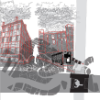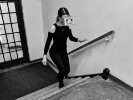A Home for C.R.A.P.

Through a series of introspective design exercises, students generated new designs by exploring the fragments of their architectural past that are omitted from the history they typically highlight in a polished portfolio of their best finished work. This studio was an opportunity for students to reflect on their architectural life thus far by unearthing and resuscitating forgotten, dismissed, or repressed experiences.
Gallery
Through a series of introspective design exercises, students generated new designs by exploring the fragments of their architectural past that are omitted from the history they typically highlight in a polished portfolio of their best finished work. This studio was an opportunity for students to reflect on their architectural life thus far by unearthing and resuscitating forgotten, dismissed, or repressed experiences.
Students were challenged to apply the Situationist understanding of architecture as an experimental space as a provocation to design a permanent home for their Collection of Repressed Architectural Pasts (C.R.A.P.) and to remark on the possible outcomes of a design fashioned from the casual fragments of everyday life
Beckingham’s memories included: learning to define routes through the disorienting streets of Venice, where Google Maps felt virtually useless; the countless trips up and downstairs while carrying dimensional lumber into the basement of Crosby; the multiple modes of climbing her group’s Ritual Space from freshman studio; and the chaotic patterns of movement in the Fabrication Workshop in Parker Hall.
Beckingham created a wearable device as an artifact that recreated feelings of disorientation through the use of mirrors and views.
These ideas influenced the design of a Navigation Museum, where stairs and periscopes are used strategically to create a disorienting environment. Beckingham sought to recreate the experience of walking through an unfamiliar place while challenging visitors to reach a level of familiarity with the museum. Visitors must rely on memorization and human navigation skills, without the assistance of handheld smart devices, to return to specific places. The exhibition provides visitors with a variety of views that influence each individual’s experience and movement through the space.

